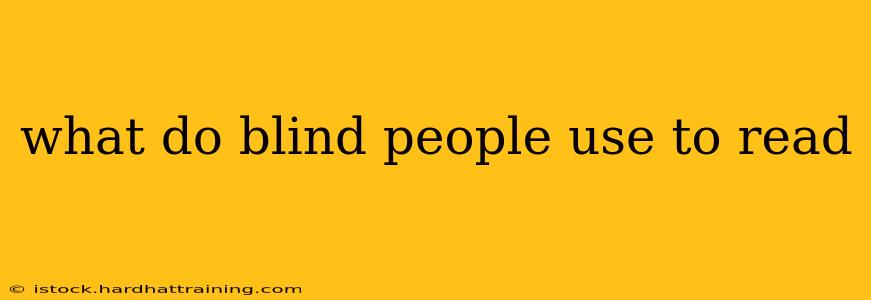Blindness doesn't equate to an inability to read. A rich world of assistive technologies empowers individuals with visual impairments to access and enjoy written material, fostering independence and enriching their lives. This guide explores the various tools and techniques used by blind and visually impaired people to read, providing a comprehensive overview of the options available.
Braille: The Tactile Language of Literacy
Braille remains a cornerstone of reading for many blind individuals. This tactile writing system uses raised dots to represent letters, numbers, and punctuation. Learning Braille requires dedicated instruction, but the reward is direct access to a vast library of braille books, magazines, and other materials. Many libraries offer braille books, and organizations like the National Library Service for the Blind and Physically Handicapped (NLS) provide extensive resources.
Types of Braille
Different braille codes exist, including:
- Grade 1 Braille: A literal translation of printed text, with each letter represented by its corresponding dot pattern.
- Grade 2 Braille: A more efficient system using contractions and abbreviations for common words and letter combinations. This significantly reduces the amount of space required for longer texts.
Screen Readers: Transforming Digital Text into Audio
Screen readers are software programs that translate digital text into audible speech, allowing blind individuals to access computers, ebooks, and online content. These sophisticated programs read aloud websites, emails, documents, and more, offering a wealth of functionalities like text-to-speech, navigation commands, and customization options. Popular screen readers include JAWS, NVDA (NonVisual Desktop Access), and VoiceOver (for Apple devices).
Features of Advanced Screen Readers:
- Text-to-speech: Converts digital text into natural-sounding speech.
- Navigation commands: Enable users to move through documents and websites efficiently using keyboard shortcuts.
- Customization options: Allow users to adjust speech rate, voice, and other settings to their preferences.
- Integration with other assistive technologies: Seamlessly work alongside other devices and tools.
Audiobooks and Podcasts: The Power of the Spoken Word
Audiobooks and podcasts provide another avenue for accessing information and entertainment. These formats are readily available through various online platforms and libraries, offering a vast library of titles catering to a wide range of interests.
Benefits of Audiobooks and Podcasts:
- Accessibility: Easy to access through various devices and platforms.
- Convenience: Can be listened to while commuting, exercising, or performing other tasks.
- Varied content: A wide range of genres and topics are available.
Large Print Books and Magnifiers: Solutions for Low Vision
For individuals with low vision, large print books and magnifying devices can significantly improve readability. Large print books use larger font sizes and increased spacing between lines to make text easier to see. Magnifiers, both handheld and electronic, can enlarge text to a comfortable viewing size.
Types of Magnifiers:
- Handheld magnifiers: Simple, portable devices for magnifying small sections of text.
- Electronic magnifiers: More sophisticated devices with adjustable magnification and lighting options.
Human Readers: The Value of Personal Connection
While technology plays a crucial role, the human element remains vital. Human readers can provide personalized assistance, reading aloud books, documents, and other materials. This personal touch offers a unique connection and can be particularly helpful for individuals who prefer a human voice or require assistance with complex or specialized texts.
Conclusion: A Multifaceted Approach to Reading
Blind and visually impaired individuals utilize a diverse array of tools and techniques to access and enjoy written material. The choice of assistive technology depends on individual needs and preferences, encompassing Braille, screen readers, audiobooks, large print materials, magnifiers, and the valuable contribution of human readers. These technologies not only facilitate reading but also promote independence, learning, and social inclusion. Continual advancements in these technologies promise even greater accessibility and opportunities for individuals with visual impairments in the years to come.
